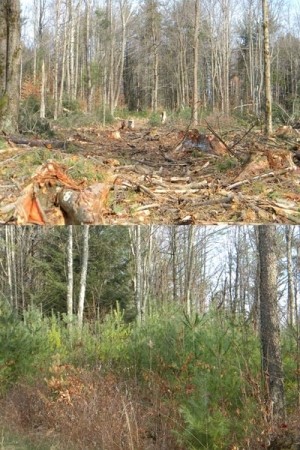We marked around 80,000 feet of marginal- to low-grade white pine in our woods recently, and the first jag – about half – has been cut and shipped north to Canada. The truckers were hauling trailers full of Christmas trees from up north down to urban markets in southern New England, then loading logs – including ours – for the return haul. Of the 35,000 feet that have been cut, 15,000 went as average sawlogs and 20,000 as pellet wood. We made nothing on the pellet wood but didn’t have to pay a logger to cut it. We averaged $19 a tree on the logs.
Our goal here was not money, thankfully, but the future. Much of the land around the 12-acre footprint of this cut is junk wood from a log buyer’s perspective. It wasn’t high graded, it wasn’t anything-graded. Eighty years ago it was open sheep pasture, and the forest came back on its own terms. Lots of pasture pine, ugly deer-coppiced red maple, and a smattering of that wavy cherry where the trunk looks like it can’t decide which direction to grow in so it just grows every which way. We’ve been working here in dribs and drabs – trying to start over – for the last decade and have had some nice success regenerating pine, which now grows in head-high carpets. By the time my theoretical grandchildren are my age, they may have some nice logs ready to cut. In the meantime, we’ve kept ourselves out of trouble by marking trees and made a little money to put towards the taxes; our logger friends have made a little money that they’ve used to help keep the wolves at bay.
This story defies the basic rules of storytelling in that it’s pretty monotonous and humble. There’s no big, sexy paycheck or instant gratification from the work that’s been done. The pine regen might come in nicely, but it’ll certainly need help to get through the ferns or non-desirable hardwood seedlings. It’ll still have to contend with weevils, deer, and weather before it amounts to anything. A month’s worth of work is just one small step in a process that will take more work and lots more time.
But I think the story is worth telling because from the outside this monotony and un-sexiness is not so immediately apparent. I know for a fact that some of our neighbors will walk on this land, see the opening pictured here, and think, “Jesus, they butchered this forest,” making the assumption that as load after load of logs left the woods that someone was getting rich. In fact, we had a well-dressed stranger stop by the yard the other day and say: “Now that you’ve logged off that land, want to sell it?” The phrase “logged off” made me wince as I imagined him thinking that we were high-grading the woods and cashing out. “Want to sell?” made me cringe, thinking maybe he did know we weren’t high-grading, that the wood was pretty much a break-even proposition, and if we could be tempted by money that would buy a shiny new truck, or less cynically, pay a medical bill, that he could get a good deal on a building lot with a hell of a view.
All over the Northeast there’s a lot of good forestry being practiced, and while some of it is aesthetically pleasing and/or financially lucrative, a lot of it – the majority of it – is a low-margin slog aimed at correcting some unfortunate history and improving a woodlot’s growing potential. Land itself is an exclusive asset that benefits a private landowner, yes, so this isn’t a call for tiny violins. But in cases where the timber is marginal, the land can be the only real, immediately lucrative asset to a landowner, which is an important point to make when we tell stories about managing the woods. These types of stories need repeating as Congress debates a fair estate tax that won’t force farmers and forestland owners to subdivide working land when it gets passed down; as the use-value taxation systems in various states are scrutinized by a new generation of legislators who may not know the difference between a white oak and a white pine; as land trusts and conservation groups promote conservation easements as a way of keeping working forestland viable and in family tree farms; as naturalists bang their drums to raise awareness of the ecological damage caused by forest fragmentation and sprawl.
Bad forestry is real easy and often pays quite well in the short term. Good forestry is often not so easy on the pocketbook. As the baby boomers retire, there are going to be more and more young timberland owners confronting the cold reality that timber returns alone may not pay the taxes or the management bills on their newly inherited forestland. Simultaneously, there will be a lot more well-dressed strangers around with checkbook in hand.



Discussion *